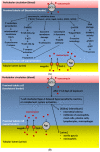Vancomycin-Associated Acute Kidney Injury: A Narrative Review from Pathophysiology to Clinical Application
- PMID: 35216167
- PMCID: PMC8877514
- DOI: 10.3390/ijms23042052
Vancomycin-Associated Acute Kidney Injury: A Narrative Review from Pathophysiology to Clinical Application
Abstract
Vancomycin is the most frequently used antibiotic, accounting for up to 35% of hospitalized patients with infection, because of its optimal bactericidal effectiveness and relatively low price. Vancomycin-associated AKI (VA-AKI) is a clinically relevant but not yet clearly understood entity in critically ill patients. The current review comprehensively summarizes the pathophysiological mechanisms of, biomarkers for, preventive strategies for, and some crucial issues with VA-AKI. The pathological manifestations of VA-AKI include acute tubular necrosis, acute tubulointerstitial nephritis (ATIN), and intratubular crystal obstruction. The proposed pathological mechanisms of VA-AKI include oxidative stress and allergic reactions induced by vancomycin and vancomycin-associated tubular casts. Concomitant administration with other nephrotoxic antibiotics, such as piperacillin-tazobactam, high vancomycin doses, and intermittent infusion strategies compared to the continuous infusion are associated with a higher risk of VA-AKI. Several biomarkers could be applied to predict and diagnose VA-AKI. To date, no promising therapy is available. Oral steroids could be considered for patients with ATIN, whereas hemodialysis might be applied to remove vancomycin from the patient. In the future, disclosing more promising biomarkers that could precisely identify populations susceptible to VA-AKI and detect VA-AKI occurrence early on, and developing pharmacological agents that could prevent or treat VA-AKI, are the keys to improve the prognoses of patients with severe infection who probably need vancomycin therapy.
Keywords: acute kidney injury; acute tubular necrosis; acute tubulointerstitial nephritis; allergic reaction; antibiotics; oxidative stress; vancomycin.
Conflict of interest statement
The authors declare no conflict of interest.
Figures


References
-
- Hoste E.A., Bagshaw S.M., Bellomo R., Cely C.M., Colman R., Cruz D.N., Edipidis K., Forni L.G., Gomersall C.D., Govil D., et al. Epidemiology of acute kidney injury in critically ill patients: The multinational AKI-EPI study. Intensive Care Med. 2015;41:1411–1423. doi: 10.1007/s00134-015-3934-7. - DOI - PubMed
-
- Petejova N., Martinek A., Zadrazil J., Kanova M., Klementa V., Sigutova R., Kacirova I., Hrabovsky V., Svagera Z., Stejskal D. Acute kidney injury in septic patients treated by selected nephrotoxic antibiotic agents-pathophysiology and biomarkers-a review. Int. J. Mol. Sci. 2020;21:7115. doi: 10.3390/ijms21197115. - DOI - PMC - PubMed
Publication types
MeSH terms
Substances
LinkOut - more resources
Full Text Sources
Medical

